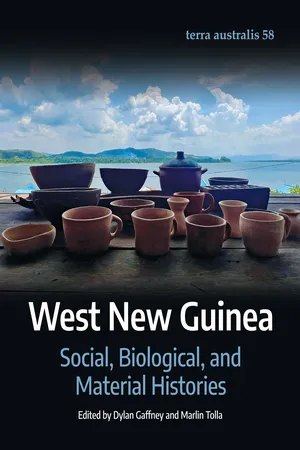
- 428 pages
- English
- PDF
- Available on iOS & Android
About this book
This book explores the human past in West New Guinea (otherwise known as Indonesian Papua, West Papua, or Irian Jaya). The western part of New Guinea and its surrounding islands were critical for the early peopling of the Pacific region over 50, 000 years ago, when Homo sapiens moved out of Africa and into Asia, seafaring through the islands of Wallacea as far as New Guinea, the Bismarck Archipelago, and the Solomon Islands. After arriving on the shores of West New Guinea, people adapted to diverse environments including coral reefs, tropical rainforests, swamps, montane cloud forests, and savannah grasslands. Over millennia, people transformed these habitats by burning and cutting the forests, translocating plants and animals, and managing access to resources. Food production later emerged in the region as the global climate warmed up around 10, 000 years ago. Between 4000–3000 years ago, the Austronesian languages began to enter West New Guinea, with its speakers settling around the coasts and offshore islands. New forms of exchange connected people and, particularly within the last 2000 years, drew West New Guinea into global networks. The objects produced and traded at ethnographic contact—like pottery, stone axes, string bags, shell ornaments, and wooden carvings—can be informative about these networks, but they are increasingly changing as people navigate and transform their material worlds in the present. The examination of these objects in museums not only casts light on their makers, traders, and collectors, but also highlights the ongoing connections that Papuans have with their material culture in the twenty-first century.
The 22 chapters in this book contribute novel perspectives and critical data on each of these themes. The authors come from archaeology, social anthropology, biological anthropology, linguistics, museology, palaeoecology, and beyond. They write about a wide array of West New Guinea's regions, including the highlands, north and south coasts, Bird's Head Peninsula, Cenderawasih Bay, and the Raja Ampat Islands.
Frequently asked questions
- Essential is ideal for learners and professionals who enjoy exploring a wide range of subjects. Access the Essential Library with 800,000+ trusted titles and best-sellers across business, personal growth, and the humanities. Includes unlimited reading time and Standard Read Aloud voice.
- Complete: Perfect for advanced learners and researchers needing full, unrestricted access. Unlock 1.4M+ books across hundreds of subjects, including academic and specialized titles. The Complete Plan also includes advanced features like Premium Read Aloud and Research Assistant.
Please note we cannot support devices running on iOS 13 and Android 7 or earlier. Learn more about using the app.
Information
Table of contents
- List of figures
- List of tables
- Preface
- 1. Introduction: The human histories of West New Guinea
- 2. A historiography of research on West New Guinea’s human past
- 3. Language as a lens into the prehistory of West New Guinea
- 4. Deep histories in New Guinea: Insights from human genetics on regional demography and archaic introgression
- 5. Deep histories in New Guinea: Insights from human genetics on local demography and social processes
- 6. Deep histories in New Guinea: Insights from genetics on human adaptation to malaria and diverse environments
- 7. A submerged landscape at the entrance of Sahul
- 8. First footsteps across the Lydekker Line: An archaeological survey in the northern Raja Ampat Islands
- 9. Last Glacial Maximum to Late Holocene occupation on the Bomberai Peninsula: Preliminary results of archaeological research at Andarewa Cave, Fakfak Regency, West Papua Province
- 10. Late Holocene human diets in the lowlands of West New Guinea: The isotopic evidence
- 11. Rock art from caves in the Keerom Regency, Papua Province
- 12. Prehistoric sites in the western Lake Sentani area, Papua Province
- 13. Decorated pottery from the Kayu Batu area, Jayapura
- 14. Tracing the remains of World War II on Biak Island
- 15. Agentive seas and animate canoes: Tangible and intangible dimensions of marine voyaging by the Marind-anim of central-southern New Guinea
- 16. Carving time: Axes and ancestrality in Asmat, West New Guinea
- 17. Shell material culture in the West New Guinea Highlands: An ethnographic kaleidoscope
- 18. Meege as bride price in Mee culture, central ranges of West New Guinea
- 19. Muyu noken (men): Shifting economic opportunities and cultural values among string bag makers and users in Merauke, southern New Guinea
- 20. A collection of relationships: Kamoro material culture in the museum
- 21. The prism of respect: Exhibiting a Raja Ampat altar
- 22. The East and West divide
- Contributors